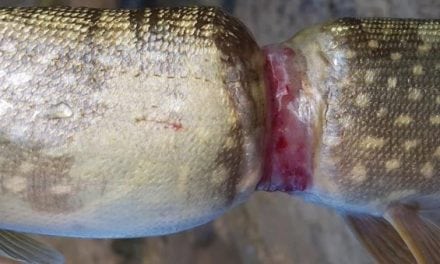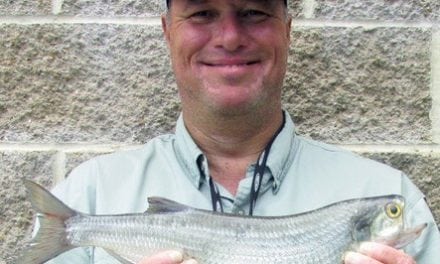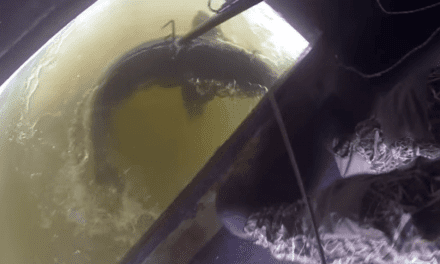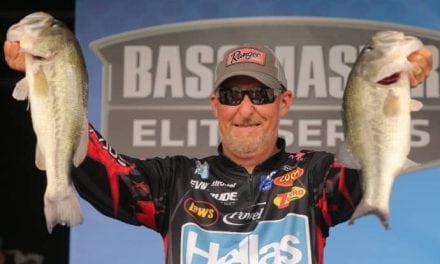Hit these Hawkeye hotspots right now for terrific fall fishing.
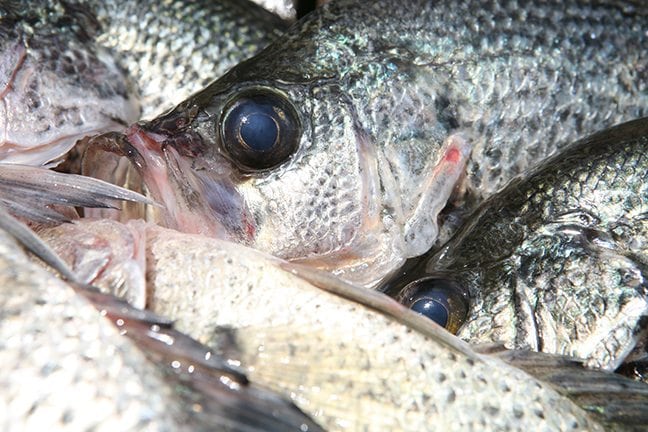
Hybrid bass, white bass, largemouth bass, walleyes, crappies and even catfish begin to feed aggressively as Iowa waters cool in September.
If you put away your fishing tackle in Iowa after Labor Day you’re missing some of the best fishing of the year. Hybrid bass, white bass, largemouth bass, walleyes, crappies and even catfish begin to feed aggressively as waters cool in September.
Anglers who know when, where and how to fish for the various species can enjoy a fishing bonanza from the final hot, hazy days of summer in early September through the first frigid days of winter in early December.
EASTERN IOWA
Chris Mack, fisheries technician with the Iowa DNR, makes sure he fishes Lake Macbride as often as possible in September, October, especially in November, and even into December.
“Last fall I was after wipers and walleyes and stumbled into some bigger walleyes,” he said. “That was in late November and early December. One of them weighed 9 pounds. I was primarily throwing jigs. About any jig will work, but later in the season jigs and minnows seem to work best. Berkley “Gulp!” minnows, or something like that. If you find walleyes at Macbride, there are usually rocks nearby — either a riprapped shoreline or around one of the reefs.”
Early last fall Mack had success landing some of Macbride’s chunky hybrid striped bass, aka, “wipers.” His work as a fisheries technician gave him an overview of the lake’s potential.
“They top out around 13 pounds, and average 3 to 6 pounds,” he said. “They range from 13 to 28 inches. In the fall I generally throw swimbaits and jerkbaits. Anything that looks like a shad seems to catch wipers when you find a school that’s feeding. I have good luck along windy, riprapped shorelines, or off the breaks of rock reefs.”
Pleasant Creek Lake, near Palo in eastern Iowa, is recovering from a major restoration project, but could be hitting on all cylinders this fall. Shoreline riprap and in-lake habitat were added during the restoration, and boat ramps and shoreline facilities were improved. The control valve was closed last winter to refill the lake.
“Since it was just a drawdown, all the predators were confined to a smaller pool with the perch and bluegills and forage fish,” said Mack. “The predators should be really fat, and the forage population should be somewhat reduced, so fishing should really take off once the lake is refilled enough so guys can use the boat ramp and all the new shoreline structure.”
It will take time for Pleasant Creek’s fish populations and anglers to figure out all of the new habitat, but if past experience is any indication, windy, riprapped shorelines will attract white bass, wipers and the anglers who seek them. Walleyes will favor riprapped shorelines as well as several rock reefs now scattered around the lake’s basin. Crappies and crappie anglers will favor the numerous brushpiles that were added to the lake during the restoration.
Crappie anglers in eastern Iowa always keep an eye on Coralville Lake, renowned for both its slab crappies as well as its fickleness. The flood control reservoir just north of Iowa City on the Iowa River holds plenty of crappies; the challenge for anglers is its erratic water level and variable water clarity in spring and summer. In the fall, however, Iowa’s weather is traditionally stable, somewhat dry, and Coralville often stabilized and smiles on anglers who know where and how to fish the lake’s unique topography.
“In the fall, if you can find any brush in the lake, you’ll probably find crappies,” said Mack. “Otherwise, I’d fish the rock walls. The brushpiles are easier to fish because you’re fishing over or beside them at a specific depth. The rock walls are tricky because you’ve got to fish tight against them and match the depth of your jig or lure to the depth where the crappies are suspending off that wall.”
Mack theorizes that crappies like vertical or near-vertical walls at Coralville because of the nooks and crannies that hold and attract invertebrates and forage fish, as well as the simplicity of responding to weather changes. Crappies are famous for moving deeper or shallower in the water column in response to changes in weather, or to daylight penetration between daylight and dark.
“With a vertical wall, they just have to move straight up or down,” said Mack. “If they’re on a point or some sort of horizontal structure they may have to swim 10 yards sideways to move 5 or 10 feet vertically. It’s just more efficient for them to be suspended off one of the walls.”
Coralville offers anglers crappies in a range of sizes.
“There are a couple year-classes in Coralville now,” he said. “There’s one class in the 7- to 9-inch range, and another group that run 10- to 12-inches. But there’s also a good number of crappies up to 13 or 14 inches in there. Because Coralville can be a little turbid, I tend to lean toward chartreuse, pink, and bright colored jigs, maybe a little bigger jig than average, because those bigger crappies are more interested in bigger baits.
“At Macbride, which is clearer, I’ll use more white, blue and silver, maybe white and blue colored jigs. I think shad have a little blue in them when they flash, so when the water is clear, I think silver and blue is a good combination for crappies.”
SOUTH AND SOUTHWEST
The sort of fishing phenomenon that Pleasant Creek in eastern Iowa will experience as it roars back from its restoration, that’s what Little River Lake in southern Iowa has enjoyed since its restoration was completed in 2011. Fisheries biologist Andy Jansen said that if last year was any indication of how things will go this fall, anglers should prep for a great season.
“The fall bite for bluegills was phenomenal at Little River in September and early October last year,” he said. He suggested anglers focus on the cedar tree brushpiles for panfish during fall.
The greatest number of brushpiles at Little River is along the shoreline near the boat ramp on the lake’s southeast arm, just off the dam. There are also brushpiles associated with the fishing jetty west of the boat ramp on the lake’s east arm, and southeast of the mid-lake campground.
Little River has long been known for its walleyes, and the renovation has only enhanced that reputation. Numbers are strong, and sizes are approaching 6 to 7 pounds. The addition of thousands of feet of riprapped shoreline along every major point provides targets for walleye hunters, but the “secret” hotspots for walleyes are rock reefs scattered around the lake. A reef off the rocked point just west of the midlake campground, a reef out in the bay across the lake due south of that campground, and reefs off the shore at the west end of the dam are prime spots for Little River’s walleyes.
Catfish anglers have learned that early autumn is a great time to catch catfish, and Lake Icaria and Green Valley Lake rate well among Jansen’s fall fishing opportunities. The warm weather of early September sees a continuation of traditional late summer nighttime or early evening catfishing strategies. The transition into cooler weather in late September and October moves the bite to fully daytime but doesn’t cool the eagerness of channel cats to chow down in preparation for winter.
“Lake Icaria has a good population of channel catfish of all sizes, but especially in the 15- to 22-inch range,” noted Jansen. “Catfishing at Icaria was excellent last fall, especially around the fishing jetties and fish mounds. Anglers seeking numbers should definitely put Icaria on their list. Catfish anglers looking for larger catfish should try Green Valley Lake (north of Creston.) We received reports of 10-pound and larger channel cats being caught at Green Valley during the late summer and into fall of 2016.”
Farther east, Fisheries biologist Mark Flammang said Lake Rathbun’s white bass fishery has been amplified by stockings of hybrid striped bass (wipers.)
“The addition of hybrid striped bass a few years ago has really given us a bump,” he said. “Activity for whites and hybrids has been excellent from May through October. Crappie at Rathbun can be really good in the fall, too. They’re currently in the 12-inch range.”
For bass anglers, Flammang recommends a trip to Lake Wapello, near Drakesville. He said that lake is currently one of the hottest largemouth bass lakes in the state.
“Even I can catch large bass there,” he joked.
CENTRAL STATE
Anglers in central Iowa have plenty of fishing opportunities as summer transitions into fall, and even into early winter. Catfishing is one of the opportunities that lasts longest.
Studies of radio-tagged catfish by Greg Gelwicks of the Iowa DNR revealed that both flathead and channel catfish in many of Iowa’s rivers migrate toward wintering holes in late fall. Anglers in the Des Moines area have discovered several of those wintering holes in both the urban stretches of the Des Moines and Raccoon Rivers. Fishing near those holes in November gives anglers access to concentrations of flatheads and channel cats still actively feeding in preparation for winter that were previously spread across miles and miles of those rivers during the summer.
Other autumn angling opportunities bracket Des Moines. Saylorville Lake to the north, and Red Rock Lake to the south, both provide hot wiper and white bass fishing well into October. At Saylorville the white bass/wiper bass bite shifts from the shallow flats off Sandpiper Beach to deeper flats along the old river channel south of the Mile Long Bridge as water temps cool in late September.
At Red Rock, whites and wipers still feed off the rock cliffs and walls after Labor Day, but move deeper as water temperatures cool. Red Rock also harbors monster, 14-inch and larger crappies that can go on a binge in October. Look for them in 10 to 15 feet of water near any rock walls or washed-in woody debris.
NORTHERN WATERS
Fisheries biologist Scott Grummer included a number of fishing opportunities at Clear Lake as some of the season’s best.
“We definitely see an increase in yellow bass catch rates in fall,” he noted. “The yellows school-up as the water cools and the guys do real well all the way through freeze-up. There’s an older year-class that average 9 inches, which is big for yellow bass, that are nearing the end of their life span. Guys do real well drifting the flats toward the west end to find a school, then they anchor and vertical jig.”
Clear Lake currently has a strong population of walleyes that should just be reaching the 14-inch minimum length limit this fall. The trick will be to get their attention.
“With all the young-of-the-year yellow bass and other forage fish that are in Clear Lake, it can be tough angling for walleyes in the fall,” he said. “One technique that works well for some anglers is to fish around lighted docks after sunset. All summer there were insects around the lights, which attracted forage fish, which attracted predators. So by fall, fish are sort of trained to go to those lighted docks after dark.”
Clear Lake is also home to eye-catching muskies. Grummer said surveys show a healthy population of 35- to 45-inch muskies in the lake. DNR workers have seen muskies up to 48 inches in their nets, and there are rumors of anglers landing 50-inchers from the edges of weedbeds along the north shore.
Whether you’re seeking world-class muskies, a livewell full of yellow bass or an encounter with an 8-pound walleye, those opportunities are available in the cool waters of Iowa’s lakes and rivers this fall. Fishing season doesn’t end after Labor Day — it just gets its second wind.
More G&F Articles on Fall Fishing
- Prime Fall Fishing Trips in Pennsylvania
- Hot Fall Inshore Fishing for Reds, Trout, Flounder & More
- 5 Top Fall Fishing Trips in Illinois
- Florida’s Fall Fishing Bonanza
The post Fall Fishing for Crappie, Walleye, Bass, Catfish, ‘Wipers’ appeared first on Game & Fish.












